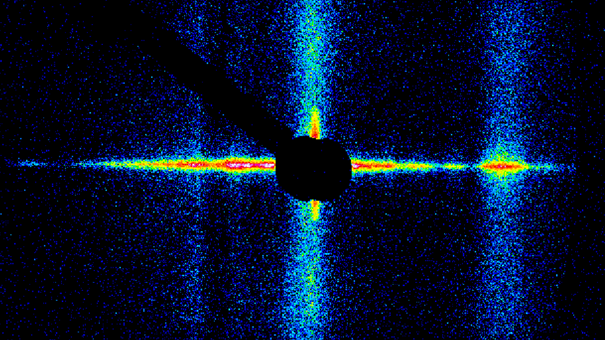PRESS RELEASE
Ultrafast surface nano-dynamics observed
~Single X-ray laser pulses can be used to observe ultrafast changes on material surfaces with unprecedented depth and time resolution~
An international team of researchers led by European XFEL and the University of Siegen has demonstrated at the SACLA Free-electron laser facility in Japan for the first time the observation of surface ablation and subsurface density dynamics with picosecond temporal and nanometer depth resolution. The results were measured by single-shot grazing-incidence x-ray scattering and opened new perspectives for laser material processing and high-energy-density science. The team published their results in the journal Physical Review Research.
The laser field interacts with electrons within a depth of a few tens of nanometers - the so-called skin depth. Several physical processes occur after the laser pulse on picoseconds to nanoseconds leading to thermalization, diffusion, compression, and ablation which finally results in a new surface structure. A good understanding and control of these processes enable high-precision material processing and functional surfaces production.
Furthermore, the interaction of such high-intensity lasers with solids is of big interest in the prospect of creating bright and compact particles and gamma-ray sources. In these experiments, the surface density profile is often perturbed before the arrival of the laser pulse.
Grazing-incidence x-ray scattering has been widely used at synchrotron facilities, i.e. to study surface growth processes occurring on time scales from milliseconds to hours. “We have extended this technique to x-ray free-electron lasers to improve the temporal resolution by nine orders of magnitude - from milli- to picoseconds,” says Lisa Randolph, a postdoc at the University of Siegen and the first author of the study.
A metallic multilayer sample was irradiated by an optical high-intensity laser. After a variable delay, the sample was irradiated with x-rays at a grazing-incidence angle - slightly above the total external reflection angles. The strong specular peak was blocked by a beamstop as it is many orders of magnitude more intense than the scattered signal. From these GISAXS patterns, the scientists were able to reconstruct the electron density profiles of the multilayer sample for several picoseconds after laser irradiation. “After the reconstruction of electron density profiles we compared these with two state-of-the-art simulation codes,” explains Mohammadreza Banjafar from European XFEL and from the Technical University of Dresden, the second author of the study.
“However, many physical effects are still missing even in these particle-in-cell simulations,” says Motoaki Nakatsutsumi from European XFEL, principal investigator of the experiment. “Our method will help to further improve the modeling of laser–solid interactions and to devise new applications for them.” In particular, the researchers expect the unprecedented possibilities enabled by their new technique to open up new perspectives for laser material processing and high-energy-density science.
“We are very pleased about the successful experiment at SACLA”, says Toshinori Yabuuchi, a leading scientist at the EH6 station of SACLA. “The high resolution and sensitivity of ultrafast GISAXS are expected to make a decisive contribution to a better understanding of high-energy-density science.”

Single-shot grazing-incidence small-angle x-ray scattering image obtained from a multilayer sample measured at SACLA EH6. The central black circle is the beamstop, to block the specular reflection peak which is many orders of magnitude more intense compared to the diffuse scattering pattern shown here. The intense XFEL photon flux made a decisive role to enable the ‘single-shot’ GISAXS. In the figure, the horizontal axis indicates Qz, which contains the information on the depth-resolved density profile, while the vertical axis indicates Qy, which contains the information on the surface structure, e.g. roughness profile.

Multilayer samples used in the experiment. Each sample has a 4 x 7 mm in size. A new sample is used after each single laser irradiation.
Publication
L. Randolph, M. Banjafar, T.R. Preston, T. Yabuuchi, M. Makita, N.P. Dover, C. Rödel, S. Göde, Y. Inubushi, G. Jakob, J. Kaa, A. Kon, J.K. Koga, D. Ksenzov, T. Matsuoka, M. Nishiuchi, M. Paulus, F. Schon, K. Sueda, Y. Sentoku, T. Togashi, M. Bussmann, T.E. Cowan, M. Kläui, C. Fortmann-Grote, L. Huang, A.P. Mancuso, T. Kluge, C. Gutt and M. Nakatsutsumi,
“Nanoscale subsurface dynamics of solids upon high-intensity laser irradiation observed by femtosecond grazing-incidence x-ray scattering”,
Phys. Rev. Res. Volume no. 4, issue no. 3, page number 033038 (2022)
